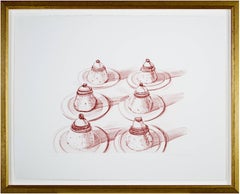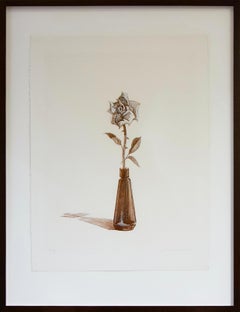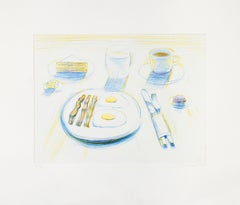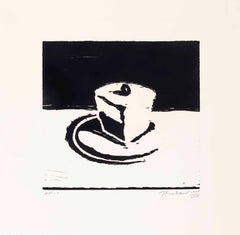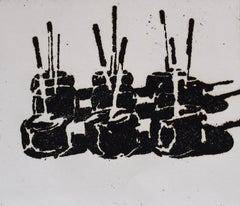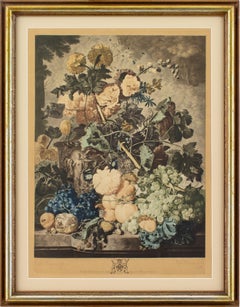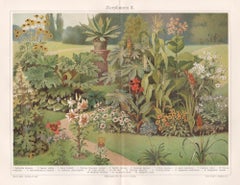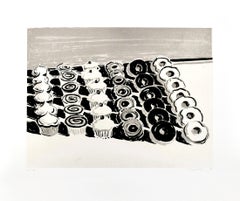Wayne Thiebaud Still-life Prints
Wayne Thiebaud’s pastel-hued still-life paintings and prints of baked goods, gumball machines, hot dogs and paint cans are often associated with the Pop art movement, thanks to the mass-cultural appeal of their content. Stylistically, however, Thiebaud eschewed the precision found in the art of such Pop giants as Roy Lichtenstein and Andy Warhol in favor of a more painterly approach, not unlike that of the Italian modernist Giorgio Morandi, whose dreamy paintings of vessels and household objects are simple yet richly atmospheric.
Thiebaud was born in Mesa, Arizona, in 1920 and grew up in Southern California from the age of six months. As a high schooler, he had a summer apprenticeship at Walt Disney Studios, which led to a stint as a graphic artist in the U.S. Army Air Forces’ First Motion Picture Unit during World War II. After the war, he attended the California State College at Sacramento on the G.I. Bill, graduating with a bachelor’s degree in 1951 and earning a master’s soon after. He went on to teach at the University of California, Davis, from 1960 to ’91.
In the late ’50s, time spent living in New York City proved crucial to Thiebaud’s career. There, he befriended Abstract Expressionist painters Willem de Kooning and Franz Kline and drew inspiration from the work of Jasper Johns and Robert Rauschenberg. Admiring the color and form on display in New York’s many bakeries, he began painting small canvases featuring rows of treats, which would become one of his central subjects. Though Thiebaud himself doesn’t identify as a Pop artist, the first major exhibition that brought him national renown was a seminal 1962 Pop show at the Sidney Janis Gallery in Manhattan. That same year, he was included in "New Painting of Common Objects” at the Norton Simon Museum of Art at Pasadena, which also featured paintings by Ed Ruscha and Jim Dine. Iconic works such as Pie Counter (1963) demonstrate Thiebaud’s signature treatment of commonplace items with the grandeur and scale of a landscape.
Thiebaud’s interest in exaggerated colors and vernacular subject matter — characteristics that call to mind images found in mid-century advertising — made him an intriguing figure occupying the hazy borderlands between fine and commercial art. Yet through a masterful handling of paint, evocative use of light and poignant sense of isolation, Thiebaud’s work is unquestionably thoughtful and singular. His later forays into landscape painting, as seen in Steep Street (1989) or Country City (1988), bring to bear his bold use of color on complex urban scenes.
Pieces by Thiebaud can be found in the collections of major museums, including the Whitney Museum of American Art, the Los Angeles County Museum of Art and the Hirshhorn Museum and Sculpture Garden, among many others. In 1994, he was awarded the National Medal of Arts by President Bill Clinton.
Find original Wayne Thiebaud art on 1stDibs.
1970s Contemporary Wayne Thiebaud Still-life Prints
Etching
1970s Wayne Thiebaud Still-life Prints
Etching
Late 20th Century Pop Art Wayne Thiebaud Still-life Prints
Paper, Drypoint, Etching
Early 2000s Pop Art Wayne Thiebaud Still-life Prints
Woodcut
1960s Pop Art Wayne Thiebaud Still-life Prints
Etching, Aquatint
20th Century Pop Art Wayne Thiebaud Still-life Prints
Etching
20th Century Wayne Thiebaud Still-life Prints
Etching
1660s Post-War Wayne Thiebaud Still-life Prints
Etching
21st Century and Contemporary Contemporary Wayne Thiebaud Still-life Prints
Etching, Aquatint
21st Century and Contemporary Pop Art Wayne Thiebaud Still-life Prints
Etching
1910s Dutch School Wayne Thiebaud Still-life Prints
Paper, Aquatint
Early 20th Century Naturalistic Wayne Thiebaud Still-life Prints
Lithograph
Early 2000s Pop Art Wayne Thiebaud Still-life Prints
Offset
2010s Contemporary Wayne Thiebaud Still-life Prints
Etching
1980s Pop Art Wayne Thiebaud Still-life Prints
Lithograph, Offset
1990s Pop Art Wayne Thiebaud Still-life Prints
Paper, Screen
1980s Pop Art Wayne Thiebaud Still-life Prints
Screen
1970s Wayne Thiebaud Still-life Prints
Drypoint, Etching
2010s Contemporary Wayne Thiebaud Still-life Prints
Paper, Drypoint, Etching
1980s Pop Art Wayne Thiebaud Still-life Prints
Lithograph, Offset
1980s Pop Art Wayne Thiebaud Still-life Prints
Screen
1990s Pop Art Wayne Thiebaud Still-life Prints
Paper, Screen
1990s Pop Art Wayne Thiebaud Still-life Prints
Lithograph, Offset
Early 2000s Modern Wayne Thiebaud Still-life Prints
Engraving
2010s Modern Wayne Thiebaud Still-life Prints
Drypoint, Etching
Early 2000s Pop Art Wayne Thiebaud Still-life Prints
Drypoint, Etching, Aquatint
Early 2000s Pop Art Wayne Thiebaud Still-life Prints
Engraving
Early 2000s Contemporary Wayne Thiebaud Still-life Prints
Screen
1960s Pop Art Wayne Thiebaud Still-life Prints
Paper, Lithograph
1970s Pop Art Wayne Thiebaud Still-life Prints
Linocut
1970s Pop Art Wayne Thiebaud Still-life Prints
Etching, Aquatint
Late 20th Century Contemporary Wayne Thiebaud Still-life Prints
Drypoint
1990s Pop Art Wayne Thiebaud Still-life Prints
Lithograph, Paper
2010s Contemporary Wayne Thiebaud Still-life Prints
Drypoint, Etching
Wayne Thiebaud still-life prints for sale on 1stDibs.
Artists Similar to Wayne Thiebaud
- 1stDibs ExpertAugust 8, 2024Wayne Thiebaud is best known for his work as an artist. His pastel-hued still-life paintings and prints of baked goods, gumball machines, hot dogs and paint cans are often associated with Pop art for the way they respond to popular culture. Stylistically, however, Thiebaud eschewed the precision found in the art of such Pop giants as Roy Lichtenstein and Andy Warhol in favor of a more painterly approach, not unlike that of the Italian modernist Giorgio Morandi, whose dreamy paintings of vessels and household objects are simple yet richly atmospheric. Pieces by Thiebaud can be found in the collections of major museums, including the Whitney Museum of American Art, the Los Angeles County Museum of Art and the Hirshhorn Museum and Sculpture Garden, among many others. In 1994, he was awarded the National Medal of Arts by President Bill Clinton. On 1stDibs, shop a selection of Wayne Thiebaud art.
- 1stDibs ExpertMarch 15, 2024Wayne Thiebaud used a variety of mediums to produce his paintings, drawings and prints. The brilliant late artist worked in charcoal, graphite, ballpoint, oil paint, ink, colored pencil, watercolor, pastel and gouache. He is best known for his works depicting everyday objects, such as cosmetics, desserts and paint cans. On 1stDibs, find a selection of Wayne Thiebaud art.
- 1stDibs ExpertApril 5, 2022Wayne Thiebaud is often associated with the pop art movement because he focused on common objects. His particular style predates the pop art movement, which accounts for the sometimes classification and the influences of modern art in his work as well. On 1stDibs, find a variety of original artwork from top artists.
- 1stDibs ExpertMarch 22, 2022Wayne Thiebaud used oil paints, pastels and charcoal to produce his paintings. In addition to painting, the artist produced etches, lithographs, linocuts and silkscreens. His paintings of pastries and landscapes are especially well known. Shop a range of Wayne Thiebaud art on 1stDibs.
- 1stDibs ExpertSeptember 9, 2024How much Wayne Thiebaud's paintings are worth varies based on their size, history, condition and other factors. In 2020, his Four Pinball Machines sold for over $19 million at a New York auction. Thiebaud’s pastel-hued still-life paintings and prints of baked goods, gumball machines, hot dogs and paint cans are often associated with the Pop art movement, thanks to the mass-cultural appeal of their content. Stylistically, however, Thiebaud eschewed the precision found in the art of such Pop giants as Roy Lichtenstein and Andy Warhol in favor of a more painterly approach, not unlike that of the Italian modernist Giorgio Morandi, whose dreamy paintings of vessels and household objects are simple yet richly atmospheric. If you own a Thiebaud painting, a certified appraiser or experienced art dealer can help you determine how much it may be worth. On 1stDibs, explore an assortment of Wayne Thiebaud art.
- 1stDibs ExpertMarch 22, 2022Wayne Thiebaud became interested in art he saw in the world around him as a child. When he was a teenager, he made money designing posters for a cinema in his town. He received his formal education from Long Beach Polytechnic High School and the Frank Wiggins Trade School in Los Angeles. On 1stDibs, shop a range of Wayne Thiebaud art.
